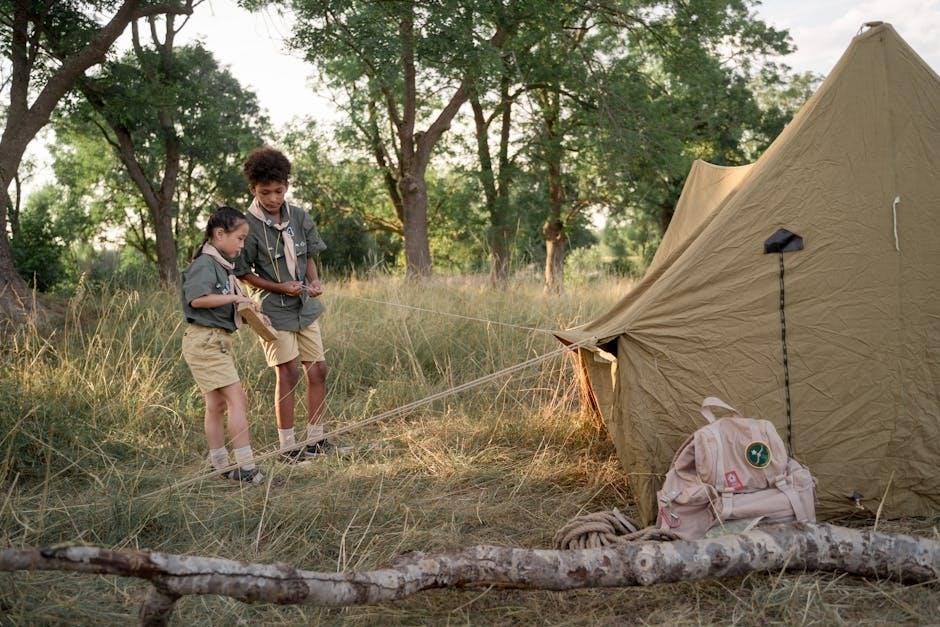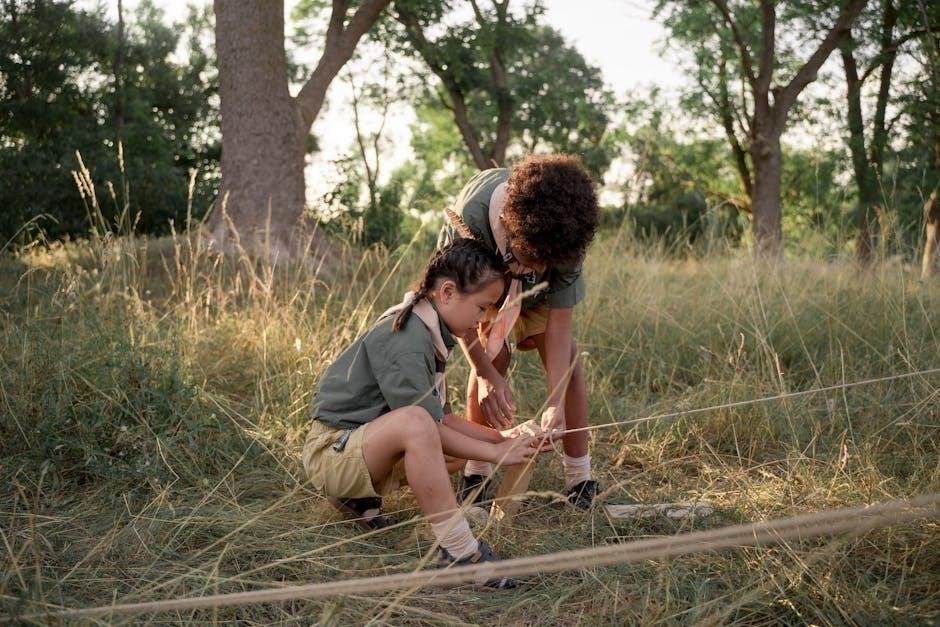Tent guide ropes, also known as guylines, are essential for securing tents, providing stability and support against wind, rain, and snow. They ensure a taut structure, preventing sagging and enhancing safety for campers in various weather conditions.
What Are Tent Guide Ropes?
Tent guide ropes, often called guylines, are durable cords or strings attached to tents to enhance stability and secure the structure. Typically made of weather-resistant materials like nylon or polyester, they are designed to anchor the tent to the ground, trees, or other stable objects. These ropes help maintain the tent’s shape, prevent sagging, and provide extra support during windy or rainy conditions. They are an essential component for campers, ensuring a safe and secure shelter in various outdoor environments.
Why Are Tent Guide Ropes Important?
Tent guide ropes are crucial for ensuring a tent’s stability and structural integrity, especially in harsh weather conditions. They prevent the tent fabric from sagging and flapping, which can lead to damage or collapse. By securing the tent tightly to the ground or anchors, guide ropes enhance safety, reduce wear and tear, and provide a more comfortable camping experience. Their importance lies in their ability to withstand external forces like strong winds and heavy rains, making them an indispensable component for campers seeking reliable shelter in the outdoors.

Choosing the Right Tent Guide Ropes

Selecting the right tent guide ropes involves considering durability, length, and features like reflectivity or adjustability. Durable materials ensure longevity, while reflective ropes enhance visibility at night.
Material and Durability
Tent guide ropes are typically made from durable materials like nylon, polyester, or paracord, ensuring strength and weather resistance. Heavy-duty options often feature reflective braids for visibility. Durable ropes withstand harsh conditions, including heavy rain, wind, and snow. Look for materials with UV resistance to prevent degradation over time. Reinforced or double-braided ropes offer enhanced longevity. The choice of material directly impacts the rope’s ability to maintain tension and provide reliable support, making durability a critical factor for secure tent setups in challenging environments.

Length and Thickness
Tent guide ropes come in various lengths and thicknesses to suit different needs. Common lengths range from 3 to 6 feet for ground-level tie-outs, while longer ropes (up to 10 feet) are used for securing to distant anchors like trees or stakes. Thickness typically varies between 2mm to 5mm, with heavier-duty ropes offering greater strength and durability. Thicker ropes are ideal for larger tents or extreme weather conditions, while thinner ropes are sufficient for smaller tents in calm environments. Choosing the right length and thickness ensures proper tension and stability for your tent setup.
Reflective and Adjustable Features
Reflective tent guide ropes enhance visibility, reducing tripping hazards in low-light conditions. Many ropes feature embedded reflective materials, ensuring safety and ease of use at night. Adjustable features like tensioners or buckles allow campers to customize the rope’s tautness, ensuring optimal stability in varying weather. These features help maintain even tension, preventing sagging and structural damage. Reflective and adjustable guide ropes are essential for safety, convenience, and securing tents effectively in diverse outdoor environments.
How to Attach Tent Guide Ropes
Securely attaching tent guide ropes involves locating attachment points, tying reliable knots, and adjusting tension to ensure stability. Properly anchored ropes provide structural integrity and safety in windy conditions.
Locating Attachment Points
Attachment points for tent guide ropes are typically found on the tent’s corners, midpoints, or guy-out loops. These points are designed to distribute tension evenly, preventing sagging. Stakes or anchors should be placed at a 45-degree angle away from the tent to maximize stability. In snowy conditions, longer ropes may be needed to reach deadman anchors buried under snow. Always follow the manufacturer’s guidelines for optimal placement to ensure your tent remains secure in all weather conditions.

Tying Knots Securely
Tying knots securely is crucial for maintaining tent stability. Use reliable knots like the bowline or taut-line hitch to attach guide ropes to stakes or anchors. Ensure knots are tight and properly adjusted to withstand wind or rain. For added security, consider using tensioners to maintain consistent tension. Always test knots before relying on them, and adjust as needed to prevent slackening over time. Proper knot-tying ensures your tent remains stable and secure in various weather conditions.
Adjusting Tension Properly
Proper tension adjustment is key to ensuring tent stability. Start by attaching guide ropes snugly, then tighten gradually to avoid over-tensioning. Use tensioners or knots to fine-tune the ropes, ensuring the tent fabric remains taut without excessive stress. In windy conditions, increase tension slightly, while in rainy weather, avoid over-tightening to prevent water pooling. Regularly check and adjust tension, especially after setup or weather changes, to maintain optimal stability and prevent damage to the tent structure.

Setting Up Guide Ropes in Different Weather Conditions
Adapt guide rope setups to weather: angle stakes in wind, tighten in rain, and extend ropes in snow for stability and damage prevention.
Wind and Rain Setup
In windy conditions, angle stakes outward at 45 degrees to prevent sliding and ensure guy ropes are tightly secured. For rain, maintain a taut structure to avoid water pooling. Use reflective ropes for visibility and adjust tension regularly to compensate for wet conditions. Proper setup in wind and rain ensures stability, prevents damage, and maintains a dry, secure shelter. Always follow manufacturer guidelines for optimal performance in adverse weather.
Snow and Cold Weather Setup
In snowy conditions, use longer guy ropes (6-8 feet) to anchor tents to deadman anchors buried under snow. This prevents shifting and ensures stability. Tighten ropes before snowfall to avoid loosening from weight. Use reflective ropes for visibility and insulated tensioners to prevent freezing. Regularly clear snow from ropes and tent surfaces to maintain structural integrity. Proper setup in cold weather ensures safety and prevents damage from heavy snowloads. Always secure ropes tightly and check tension periodically to withstand harsh winter conditions effectively.

Best Knots for Securing Guide Ropes
The Bowline Knot creates a secure, adjustable loop, while the Taut-Line Hitch allows for easy tension adjustments, ensuring stability and reliability in various camping conditions.
Bowline Knot
The Bowline Knot is a fundamental and reliable knot for securing tent guide ropes. It creates a fixed loop at the end of a rope, which is ideal for attaching to tent loops or anchor points. This knot is easy to adjust and maintains tension without slipping, making it perfect for camping in windy or unstable conditions. Its secure loop ensures the tent remains stable, and it can be easily released when needed. The Bowline Knot is a must-know for campers and outdoor enthusiasts, providing a dependable solution for anchoring guide ropes effectively.
Taut-Line Hitch
The Taut-Line Hitch is a versatile and essential knot for adjusting tension in tent guide ropes. It allows for easy tightening or loosening of the rope without untying it, making it ideal for securing tents in varying weather conditions. This knot is particularly useful for maintaining taut lines in windy or rainy setups, ensuring the tent remains stable. Its simplicity and effectiveness make it a favorite among campers, as it provides a quick and reliable way to adjust guide ropes while keeping the tent secure and properly tensioned.

Maintenance and Storage Tips
Regularly clean and dry tent guide ropes to prevent mold and damage. Store them in a cool, dry place, away from direct sunlight, to maintain durability and performance.
Cleaning and Drying
Clean tent guide ropes with mild soap and water to remove dirt and grime. Avoid harsh chemicals, as they may weaken the material. Rinse thoroughly to ensure no residue remains.
Allow the ropes to air dry completely, away from direct sunlight, to prevent fading or degradation. Regular cleaning and drying help maintain durability and prevent mold or mildew buildup.
Proper Storage Techniques
Store tent guide ropes in a cool, dry place to prevent moisture damage. Use airtight containers or waterproof bags to protect them from dust and humidity. Avoid direct sunlight, as it can cause fading or weakening. Coil the ropes neatly to prevent tangling and ensure easy access for future use. Regularly inspect stored ropes for signs of wear or mold, addressing issues promptly to maintain their durability and performance.

Common Mistakes to Avoid
Incorrect tension, neglecting weather conditions, and improper knot tying are common mistakes that compromise tent stability and safety. Avoiding these ensures a secure and durable setup.
Incorrect Tension
Incorrect tension in tent guide ropes can lead to instability and damage. Overtightening may strain the tent fabric or poles, while loose ropes cause flapping and sagging. Regularly check and adjust tension, especially in windy or wet conditions, to maintain a taut structure. Use tensioners or knots to achieve the right balance, ensuring the tent remains stable without excessive stress. Neglecting proper tension can result in poor weather performance and safety risks. Always follow manufacturer guidelines for tension adjustment to avoid common mistakes.
Neglecting Weather Conditions
Neglecting weather conditions when setting up tent guide ropes can compromise the tent’s stability and safety. In windy environments, failing to tighten ropes properly can lead to flapping and potential damage. Similarly, in rainy or snowy conditions, improper tension may cause water pooling or collapse. Always adjust guide ropes according to weather forecasts, ensuring they are taut but not overly strained. Regularly inspect and tighten ropes during prolonged exposure to harsh weather to maintain a secure and stable shelter.
Tent guide ropes are indispensable for ensuring a stable and secure camping experience. By selecting the right materials, adjusting tensions properly, and using appropriate knots, campers can withstand various weather conditions. Regular maintenance and storage extend their lifespan. Neglecting guide ropes can lead to instability, making them a critical component for safety. Proper setup and care enhance overall camping comfort, ensuring a reliable shelter in all situations.

